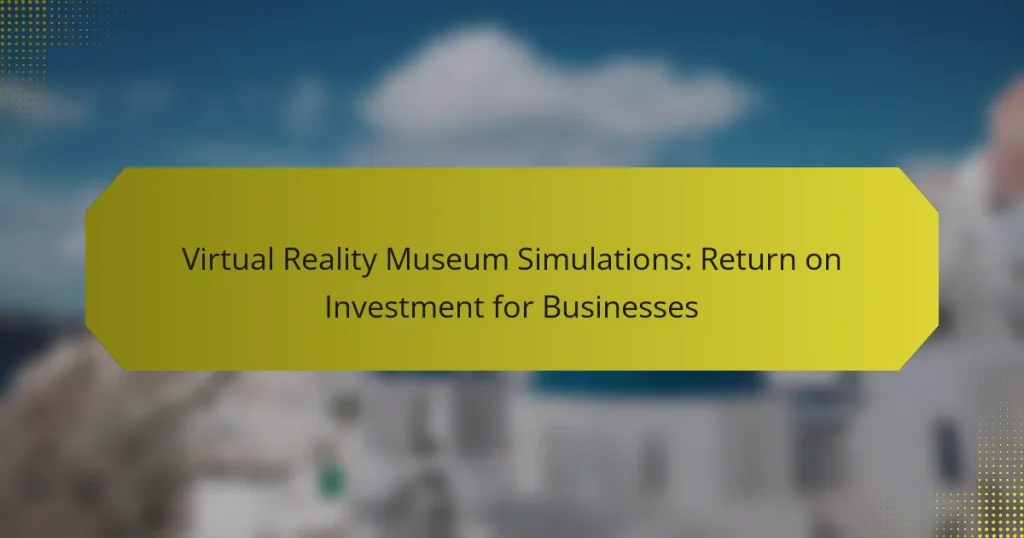Virtual reality museum simulations present a powerful opportunity for businesses to enhance visitor engagement and satisfaction while optimizing their marketing strategies. By creating immersive and interactive experiences, these simulations not only attract more visitors but also provide valuable insights into customer behavior, ultimately driving increased revenue and a strong return on investment.
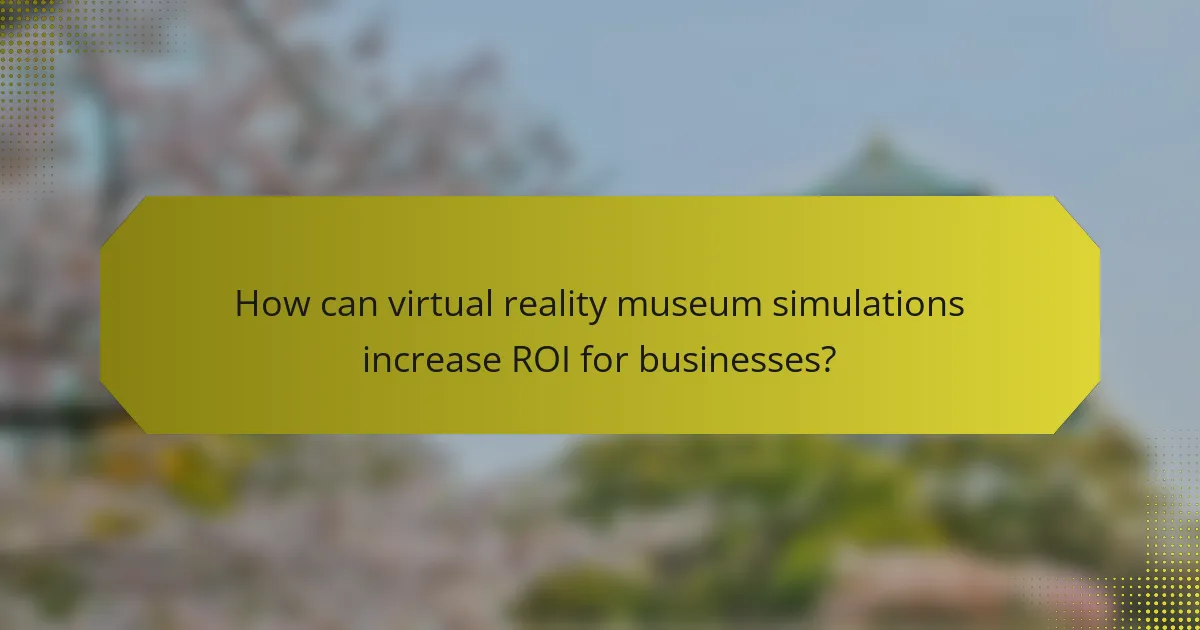
How can virtual reality museum simulations increase ROI for businesses?
Virtual reality museum simulations can significantly boost ROI for businesses by enhancing visitor experiences, reducing marketing costs, and providing valuable insights into customer behavior. By leveraging immersive technology, businesses can attract more visitors and improve engagement, ultimately leading to increased revenue.
Enhanced customer engagement
Virtual reality simulations create immersive experiences that captivate visitors, making them more likely to spend time exploring exhibits. This heightened engagement can lead to longer visits and increased likelihood of return trips, which directly contributes to higher revenue. For example, a museum offering a VR experience may see a 20-30% increase in visitor retention compared to traditional exhibits.
To maximize engagement, businesses should focus on creating interactive elements within the VR experience. Features like guided tours, gamification, and social sharing options can enhance visitor involvement and encourage word-of-mouth promotion.
Cost-effective marketing strategies
Implementing virtual reality in marketing campaigns can be more cost-effective than traditional methods. VR experiences can be shared online, reaching a wider audience without the need for physical materials or extensive travel. This digital approach reduces costs associated with print advertising and event promotions.
Additionally, businesses can utilize VR content across multiple platforms, such as social media and websites, maximizing their marketing reach. Investing in high-quality VR content can yield significant returns, especially when targeting tech-savvy demographics that appreciate innovative experiences.
Data-driven insights on visitor behavior
Virtual reality simulations provide valuable data on visitor interactions, allowing businesses to analyze preferences and behaviors. By tracking how users navigate through the VR environment, businesses can identify popular exhibits and areas needing improvement. This data can inform future exhibit designs and marketing strategies.
To effectively leverage these insights, businesses should implement analytics tools that capture user data during VR experiences. Regularly reviewing this information can help refine offerings and enhance overall visitor satisfaction, leading to improved ROI over time.
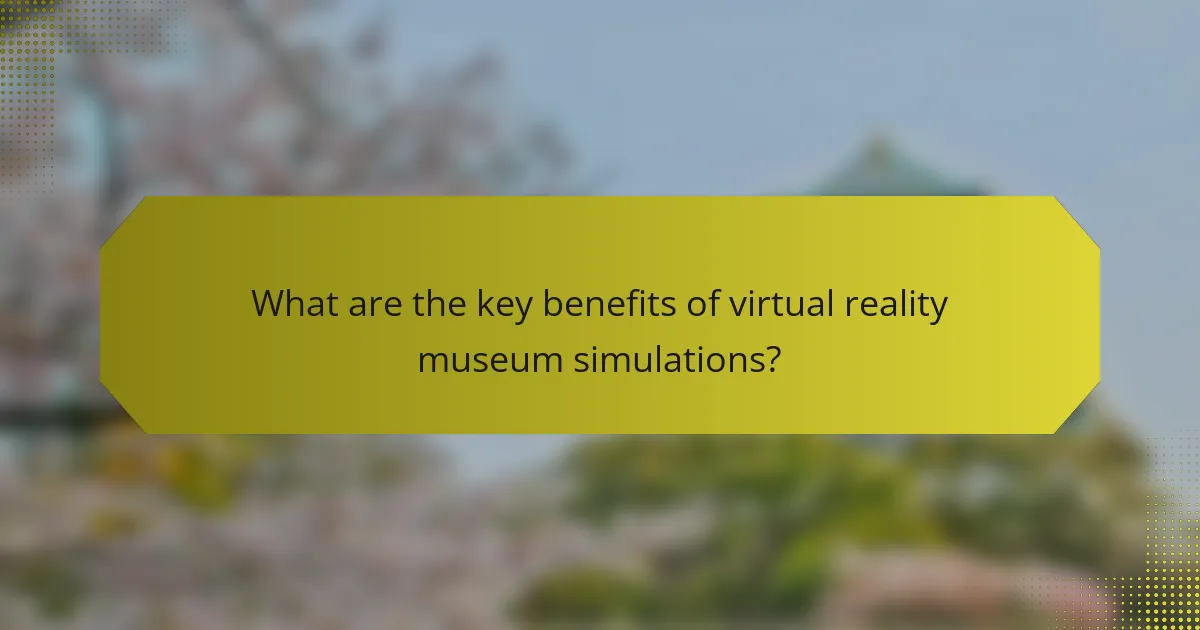
What are the key benefits of virtual reality museum simulations?
Virtual reality museum simulations offer businesses a unique way to engage audiences by creating immersive and interactive experiences. These simulations can enhance visitor satisfaction, broaden accessibility, and provide innovative branding opportunities, ultimately leading to a strong return on investment.
Immersive experiences for visitors
Virtual reality allows visitors to engage with exhibits in a way that traditional formats cannot match. By using VR headsets, users can explore detailed environments, interact with 3D artifacts, and even participate in guided tours that enhance their understanding and enjoyment.
For example, a museum could create a simulation of an ancient civilization where visitors can walk through reconstructed streets and interact with virtual inhabitants. This level of immersion can significantly increase visitor retention and satisfaction, making them more likely to recommend the experience to others.
Increased accessibility for remote audiences
Virtual reality museum simulations break geographical barriers, allowing individuals who cannot physically visit a museum to experience it from anywhere. This is particularly beneficial for people with disabilities or those living in remote areas.
By offering virtual tours, museums can reach a wider audience, potentially increasing ticket sales and donations. For instance, a museum could charge a nominal fee for access to its virtual exhibits, creating an additional revenue stream while expanding its reach.
Innovative branding opportunities
Businesses can leverage virtual reality simulations to create memorable branding experiences that resonate with audiences. By integrating brand elements into the VR experience, companies can enhance their visibility and engagement.
For instance, a museum could collaborate with a brand to sponsor a virtual exhibit, showcasing the brand’s products in a creative context. This not only provides funding for the museum but also allows the brand to connect with potential customers in a unique way.
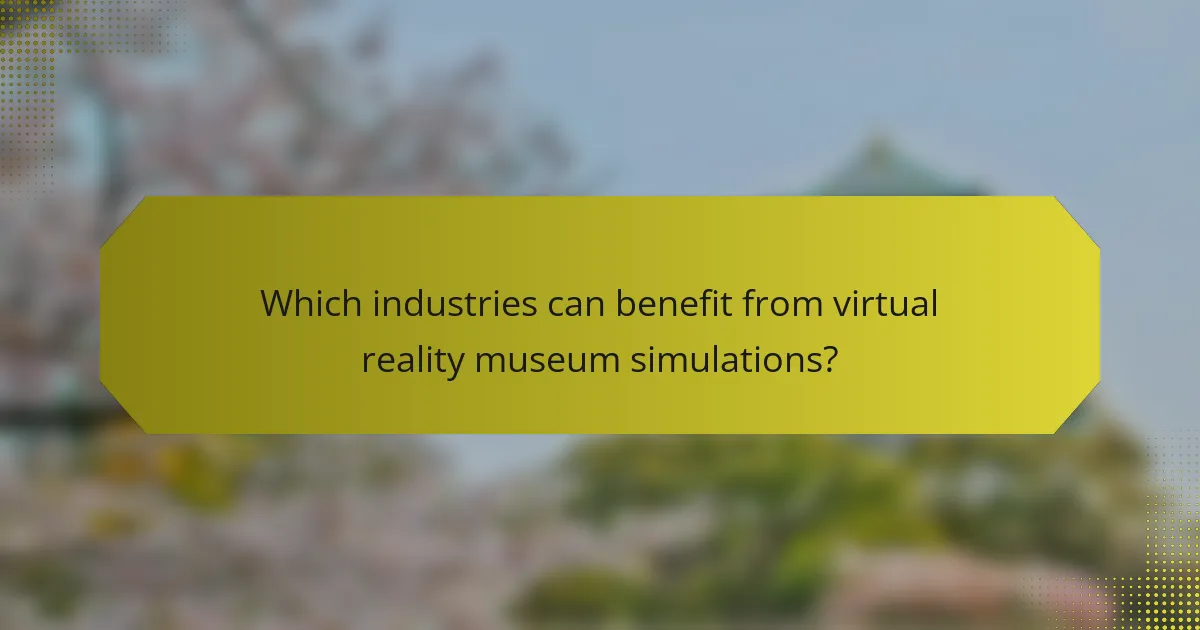
Which industries can benefit from virtual reality museum simulations?
Virtual reality museum simulations can significantly enhance engagement and learning across various sectors, particularly in art, education, and corporate training. These immersive experiences allow users to explore exhibits and concepts in a more interactive and memorable way.
Art and cultural institutions
Art and cultural institutions can leverage virtual reality to create immersive exhibitions that attract a wider audience. By offering virtual tours of galleries or historical sites, these institutions can reach individuals who may not be able to visit in person due to geographical or physical constraints.
Implementing VR experiences can also enhance visitor engagement, allowing users to interact with artworks and artifacts in innovative ways. Institutions should consider investing in high-quality VR content that reflects their unique collections and narratives.
Educational organizations
Educational organizations can utilize virtual reality museum simulations to provide students with interactive learning experiences that complement traditional curricula. VR can transport students to historical events or scientific environments, making complex subjects more accessible and engaging.
When integrating VR into educational programs, institutions should focus on aligning content with learning objectives. Collaborating with VR developers to create tailored experiences can enhance educational outcomes and foster deeper understanding.
Corporate training programs
Corporate training programs can benefit from virtual reality simulations by offering realistic scenarios for skill development and problem-solving. VR can simulate workplace environments, allowing employees to practice tasks in a safe and controlled setting.
Organizations should consider using VR for onboarding, safety training, and soft skills development. By providing immersive training experiences, companies can improve retention rates and employee confidence, ultimately leading to better performance in real-world situations.

What factors should businesses consider before investing?
Before investing in virtual reality museum simulations, businesses should evaluate initial costs, technology requirements, and content development needs. Understanding these factors can help determine the feasibility and potential return on investment.
Initial setup costs
The initial setup costs for virtual reality museum simulations can vary significantly based on the scale and complexity of the project. Businesses should budget for hardware, software licenses, and any necessary infrastructure upgrades. Typical initial investments can range from a few thousand to several hundred thousand dollars, depending on the desired quality and features.
It is crucial to consider ongoing maintenance and support costs as well. These can add an additional 15-20% to the annual budget, which businesses should factor into their overall financial planning.
Technology requirements
Investing in virtual reality simulations requires specific technology, including high-performance computers, VR headsets, and possibly motion tracking systems. Businesses must ensure that their existing hardware meets the minimum specifications for the software they plan to use.
Additionally, staying updated with the latest technology trends is essential. As VR technology evolves, businesses may need to invest in upgrades or replacements every few years to maintain a competitive edge.
Content development needs
Content development is a critical aspect of virtual reality museum simulations. Businesses must consider whether to create content in-house or outsource it to specialized developers. In-house development can offer more control but may require hiring skilled personnel, which can be costly.
Outsourcing can provide access to expertise and faster turnaround times, but it may come with higher costs. Businesses should evaluate their specific needs and budget to determine the most effective approach for content creation.

How do virtual reality museum simulations compare to traditional exhibits?
Virtual reality museum simulations offer a unique alternative to traditional exhibits by providing immersive experiences that can enhance visitor interaction and learning. While traditional exhibits rely on physical artifacts and static displays, VR simulations can create dynamic environments that engage users in innovative ways.
Cost efficiency over time
Investing in virtual reality simulations can lead to significant cost savings compared to maintaining traditional exhibits. Over time, expenses related to physical space, maintenance, and insurance for artifacts can add up, while VR requires less physical upkeep and can be updated without major renovations.
For example, a traditional exhibit might require tens of thousands of dollars annually for upkeep, while a VR setup may have a higher initial investment but lower ongoing costs, often recouping expenses within a few years. This makes VR a financially attractive option for many institutions.
Visitor engagement metrics
Visitor engagement metrics for virtual reality simulations often surpass those of traditional exhibits. Studies indicate that VR experiences can increase visitor retention and satisfaction, with many users reporting a deeper emotional connection to the content.
For instance, VR simulations can lead to engagement rates that are 30-50% higher than standard exhibits, as visitors are more likely to interact with the content and spend longer periods exploring. This increased engagement can translate into higher ticket sales and membership renewals.
Flexibility in content updates
Virtual reality museum simulations allow for rapid and cost-effective content updates, unlike traditional exhibits that may require extensive physical changes. Institutions can easily modify VR content to reflect new research, seasonal themes, or special events without the need for significant downtime or investment.
This flexibility enables museums to keep their offerings fresh and relevant, appealing to repeat visitors and attracting new audiences. For example, a museum can update its VR experience quarterly, showcasing different themes or collections, which is far more challenging with physical installations.
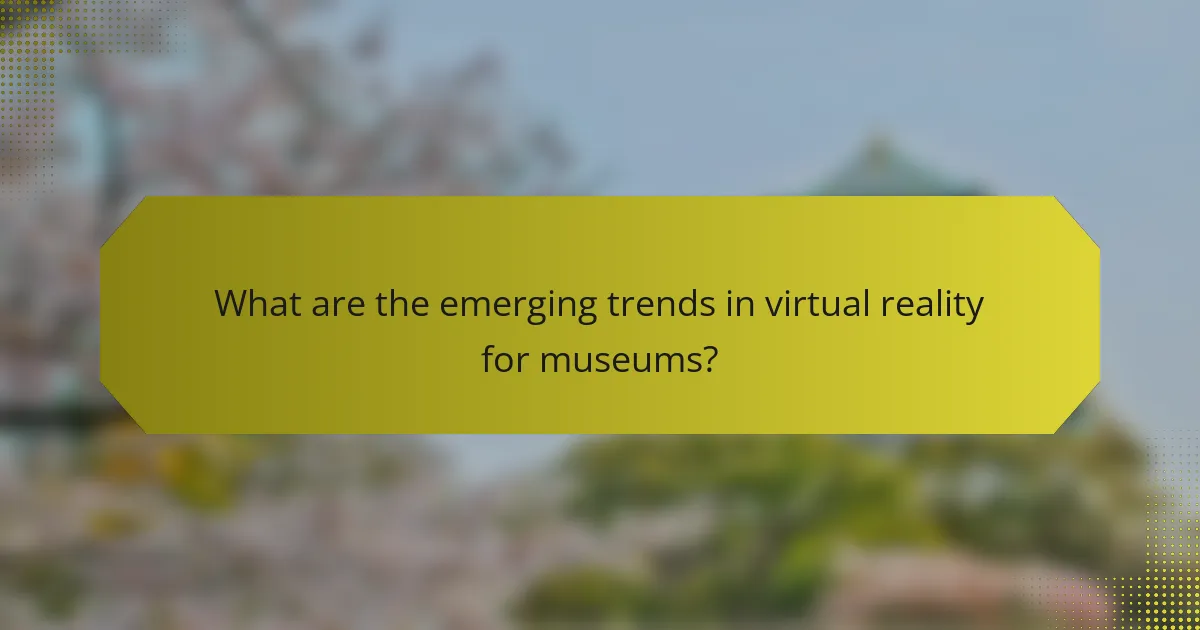
What are the emerging trends in virtual reality for museums?
Emerging trends in virtual reality (VR) for museums focus on enhancing visitor engagement and creating immersive experiences. Museums are increasingly adopting VR technology to offer virtual tours, interactive exhibits, and educational programs that cater to diverse audiences.
Increased Accessibility
Virtual reality allows museums to reach a broader audience by providing access to exhibits and collections that may be geographically or physically inaccessible. For instance, individuals with mobility challenges can explore museum spaces from their homes, making cultural education more inclusive.
Many institutions are developing VR experiences that can be accessed via smartphones or VR headsets, enabling users to engage with content anytime and anywhere. This trend not only expands the audience but also enhances the museum’s reach and relevance in a digital age.
Enhanced Educational Experiences
VR is transforming educational programs in museums by offering interactive learning opportunities. Students can participate in virtual field trips, where they can explore historical sites or scientific phenomena in a controlled, engaging environment.
For example, a history museum might use VR to recreate significant events, allowing students to experience history firsthand. This immersive approach can lead to improved retention of information and a deeper understanding of complex subjects.
Collaborative Exhibitions
Collaboration between museums and technology companies is on the rise, leading to innovative VR exhibitions. These partnerships often result in unique experiences that blend art, science, and technology, attracting diverse audiences.
Collaborative projects can include joint exhibitions that utilize VR to showcase artifacts from multiple institutions, providing a richer narrative and context. This trend not only enhances visitor experience but also fosters a sense of community among cultural institutions.
Data-Driven Insights
As museums implement VR experiences, they can gather valuable data on visitor interactions and preferences. This data can inform future exhibitions and marketing strategies, helping museums tailor their offerings to meet audience needs.
By analyzing user engagement metrics, museums can identify popular exhibits and adjust their programming accordingly. This data-driven approach can lead to more effective resource allocation and improved visitor satisfaction.
